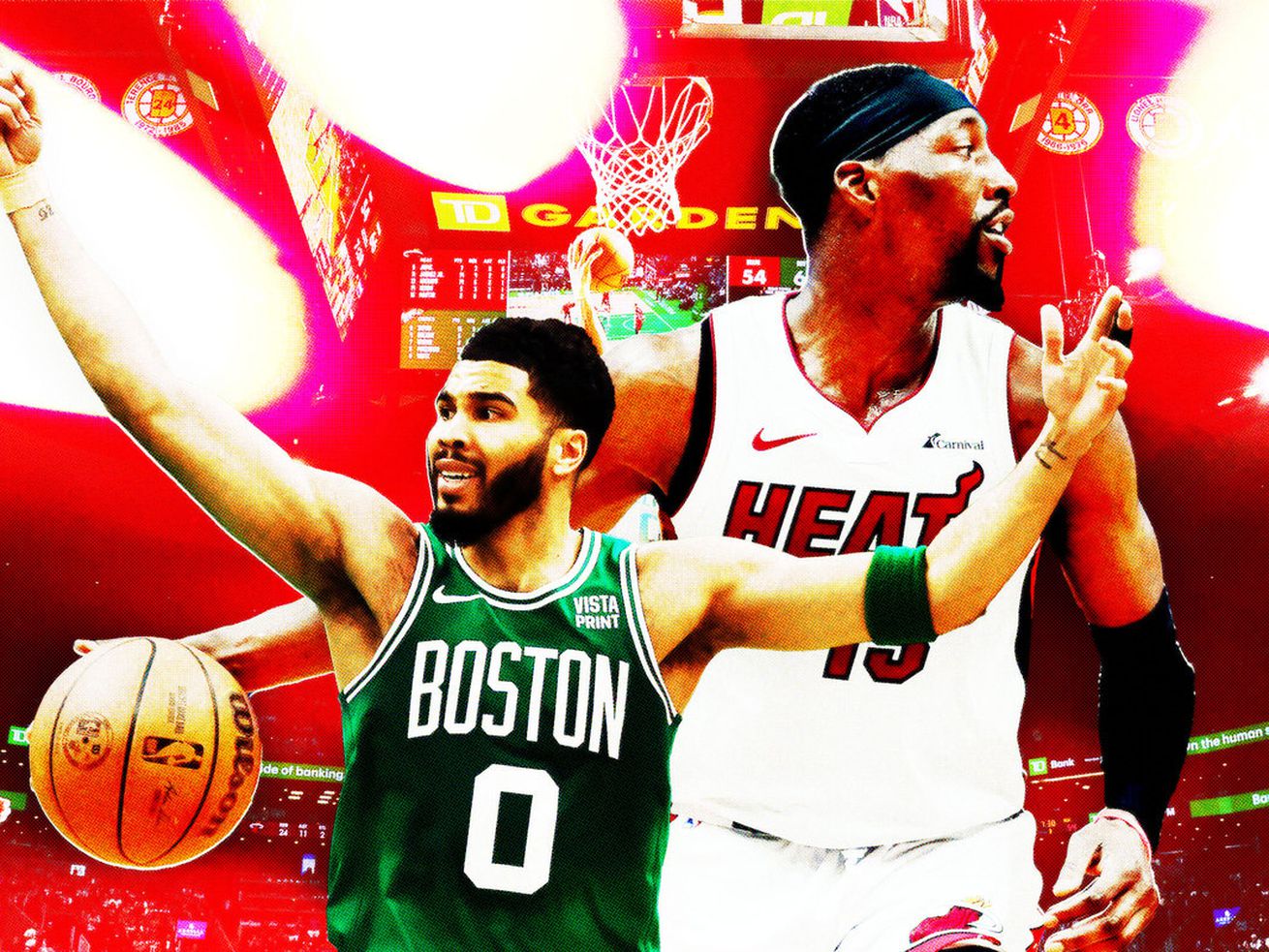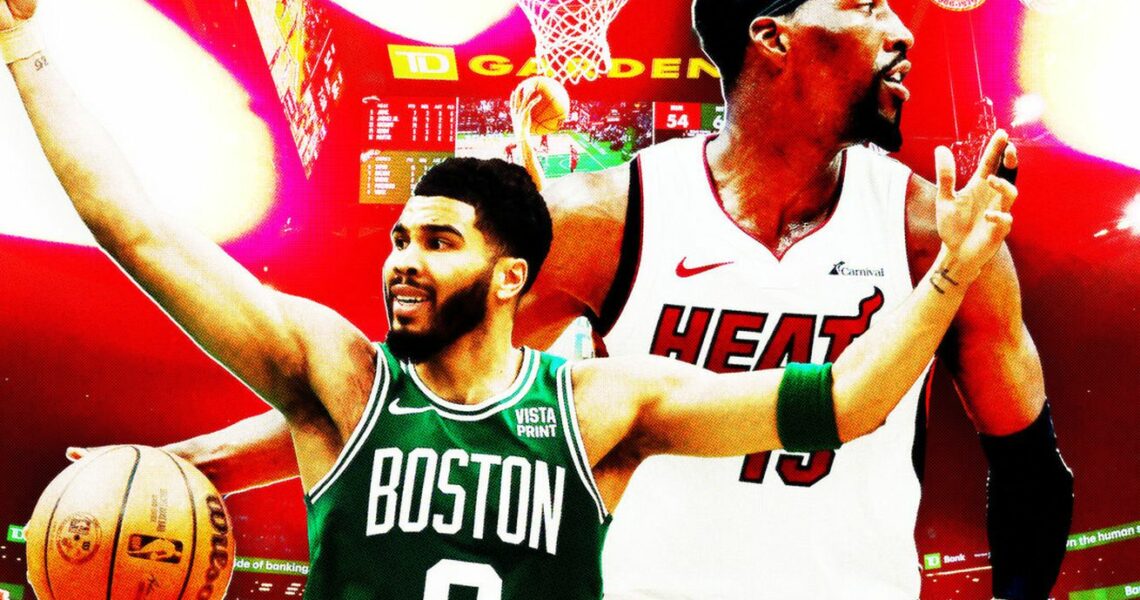
Miami’s hot 3-point shooting was the story of Game 2, but it wasn’t the anomaly that allowed the Heat to claw their way back into the series. It was something far more familiar, and potentially just as dangerous.
Back in the early days of basketball, indoor games were played in cramped gymnasium halls. The game has always tested one’s spatial awareness and peripheral vision, but back then, before the standardization of courts, players had to factor in the environment about as much as they did their opponent. Backpedal on defense without looking and you might slam your head into a pillar. Get knocked off balance and you may be left with a permanent burn scar. In the winter, these halls would be warmed with a stove stationed in the immediate vicinity — perhaps the ultimate sign of basketball’s growth over the past 100-plus years is how far the game’s been removed from literal boiler rooms.
“It has been reported that visiting players had to play with one eye focused on the stove and one on the closest opponent, else they might find that they would be pushed into it,” John M. Cooper and Daryl Siedentop wrote in the 1969 book The Theory and Science of Basketball. “This situation helped make players and coaches conscious of the possibilities of using players as screens.”
Be aware of your surroundings, or you might get burned by the Heat. Some lessons in basketball are truly timeless.
The Miami Heat return home from Boston with their series against the Celtics tied at a game apiece in a series many pegged to be the most likely to end in a sweep. That isn’t coach Erik Spoelstra’s style. This is Spo’s 13th postseason appearance. He’s now 10-3 in Game 2s after losing Game 1. He’s one of the greatest in-series adjusters in the history of the sport. Sometimes the scheme changes are subtle. In Game 2, they rang loud. From the opening tip, franchise fulcrum Bam Adebayo picked up the assignment on Jayson Tatum. Gone were the aggressive doubles on Boston’s most formidable playmakers, gone was the cheap zone.
“They make us think. They do this on one possession, then they do another thing on another possession, then they switch, then they don’t,” Porzingis told reporters on Thursday. “So that can freeze you a little bit, because you start to think a little bit, then you rush.”
Placing Adebayo on Tatum kept the Celtics from getting to their preferred areas of the court expediently, as one doesn’t just bump Bam into submission. The lack of doubles meant fewer clear release valves on the weak side to swing to. Adebayo was almost omnipresent — trained onto Tatum, which allowed him to remain engaged both on ball and as an active helper on switches. Chasing stars around, digging at the nail, freelancing as the low man — Bam made the best possible case for a Defensive Player of the Year award that will likely once again elude him. He was the wellspring of a Heat defense that, by sheer force of will, junked up the Celtics’ best-laid plans. The clock ticked, and the onus was on Tatum and Jaylen Brown to work their magic. To their credit, they did: The dynamic duo combined for 61 points on 23-for-43 from the field on Wednesday. But that efficiency was held in a silo; the Celtics, so dominant when they can swing the ball to their myriad shooters, managed only 32 attempts from deep. Miami successfully goaded Boston into a game that was not their own.
On the other side of the coin, the Heat successfully wrung out an uncharacteristically face-melting performance from behind the arc. That was the story coming out of Boston after Game 2, and the Celtics all noted the issue of having to close out better on the Heat shooters, who were wide open on a majority of their long-range attempts. The influx of 3-pointers seemed out of character for a Heat team that was in the bottom half of the league in attempts, but their sudden departure from expectation is all part of the adaptation game. The 3-pointer is an equalizing torch for teams in survival mode. The Cavaliers’ highest highs during the regular season occurred when Cleveland, on the fly, transformed itself into one of the most prolific 3-point shooting teams in the league with Evan Mobley and Darius Garland both sidelined. Upon the foundation of Miami’s top-five defense, the Heat have been emboldened to ramp up the variance against a team that knows intimately what a procession of 3s does to an opponent. The percentages won’t always be there for the Heat the way they were in Game 2, but something tells me that the attempts are only half the fun. It’s setting them up that really lights the HEAT CULTURE beacon.
It’s the psychology of — let’s call it a boiler room attack. Maybe the Celtics will actually bother to contest the likes of Haywood Highsmith from here on out, but Miami will relish in creating punishing obstacle courses all the same. Miami’s screen choreography in Game 2 was gorgeous: bumps and twirls and skipping between enemy lines. The hits accrue. Just ask Derrick White:
Ball movement and player movement key for Miami. Highsmith screens for Herro, Martin slips, quick advance to Bam to get a handoff. Celtics switch that but now Robinson comes from the corner and slips this screen for Herro. Pritchard holds, Robinson gets a 3. pic.twitter.com/zdZFlFi627
— Steve Jones Jr. (@stevejones20) April 25, 2024
White, one of the best on-ball defenders and screen navigators in the sport, gets dragged through hell on the play above. In the span of 10 seconds, he’s bumped and tagged at least four times. He starts off attached to Herro, and by the time the ball gets to Duncan Robinson’s itchy trigger fingers, he’s out of the play entirely. It’s not just the 3s, it’s the work that Miami will put Boston through in defending them. And we know the Heat are obsessed with the work. Moving forward, the Celtics will have to be prepared to run up against all those screens, night after night. (Celtics fans have bemoaned Bam’s illegal activity, to which, I’d say: After six years of witnessing Kevin Garnett, arguably the best to ever moving screen, I would have expected more appreciation of the craft!)
The big question as the series shifts to Miami is whether Boston will adjust how they defend the arc. “I know we will be better coming into next game,” Horford told reporters on Thursday. “There will be more of an awareness to that.” Hard closeouts on Heat shooters would beget different problems; Boston’s best option may simply be staying the course and trusting the talent disparity. There have been five teams in NBA history, including Miami on Wednesday, who have made at least 23 3-pointers in a playoff game. The average score of the other four teams is 128; the Heat scored 111. It took a historic night for the Heat to approach a top-10 level of offensive efficiency, a rate that the Celtics have easily cleared all season long. The 3s were the story on Wednesday night, but it wasn’t the anomaly that allowed Miami to claw their way back into this series. It was something far more familiar.
“We’ve been doubted a lot throughout our playoff runs,” said Adebayo after Game 2. “There’s people saying we couldn’t do a lot of stuff that we did. So, for me and my team, it’s like: Why lose belief now? Backs against the wall, everybody already against us, use it as fuel. A lot of people seem to think we’re going to buy into what they say, that we can’t get it done, and let it seep into our locker room. It’s different. Our guys believe we can win. We get in between those lines, we make it about basketball. We don’t make it about schemes; we don’t make it about this guy and that guy. We make it about mano a mano, get in that cage fight, and let’s hoop.”
That’s the characteristic grit and hunger that have turned Heat Basketball into a strange postseason monolith divorced from rhyme or reason. Game 2 brought those moments of confounding brilliance that lead to “dark magic” accusations with a straight and sober face. Game 2 was the kind that reminds us of why it’s so easy to ridicule the notion of HEAT CULTURE: because it toes the line of myth and reality so deftly as to establish a hyperreality. The Celtics, who have stood as analytical darlings for years on end, stand as the perfect backdrop. Boston has all the tools to vanquish the ghost once and for all. And yet, they can’t. At least not so easily.

